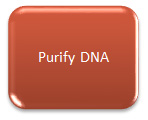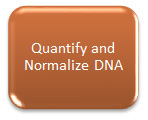Overview
Below is a description of our NAPPA Core pipeline. Each of the services that we provide is listed at the step in the pipeline in which it is created.
| 1. Grow Bacteria | |
| 2. Purify DNA | |
| 3. Quantify and Normalize DNA | SERVICE #1 – DNA Prep |
| 4. Prepare for array printing | |
| 5. Print arrays | |
| 6. Quality control analysis | SERVICE #2 – Arrays |
| 7. Sample screening | SERVICE #3 – Screening |
| 8. Slide scanning | |
| 9. Data Analysis | SERVICE #4 – Data Analysis |
Pipeline
 |
Glycerol stocks of our clones are kept frozen in both 96-well plate format and individual samples. To grow the bacteria, agar plates are spotted from the glycerol stocks to encourage competitive growth of the desired clone, and then inoculated and grown in TB media. Both of these steps use a 96-pin tool incorporated on our Biomek FX. Once grown, the pellet is spun down, the supernatant removed, and the bacteria pellet is now ready for DNA purification. |
 |
We offer two different high throughput 96-well DNA prep methods. The biggest differences between these two methods are the amount of final DNA concentration obtained, endotoxin purification capabilities, and overall cost. The DNA prep process utilizes many different pieces of equipment on the DNA factory. Click here to find out more detailed information about our DNA prep services. |
 |
All of our DNA preps are QC’d by running a full plate quantification to check for appropriate levels of DNA. The Pall prep averages 6 micrograms of DNA per well, while the Anion Resin Preps average 27 micrograms of DNA per well. The NAPPA Core offers a service to provide purified DNA using one of these two preps. You may also choose to have your plate of DNA normalized to a set concentration. |
 |
Our plasmid DNA is now ready to be prepped for printing. A printing “master mix” is added to the resuspended DNA plate and the mixture is transferred to 384-well plates. |
 |
The process is now moved over to our QArray machine where the plasmid DNA is printed onto the arrays in batches of 90 slides at a time. The QArray contains a 48-pin head and can print a maximum of 2,352 spots per array. The NAPPA Core offers both standard and custom arrays as a service to the research community. |
 |
For each batch of 90 slides printed, two slides are used for a Pico Green analysis to measure the display of plasmid DNA printed, and two slides are used in a protein expression analysis to measure the display of proteins expressed. This protein expression is performed on our Tecan HSPro 4800. The expressed slides are then used in a QC analysis to determine the percentage of spots that are above the threshold of a raw intensity value of 10 million, and to check for positive and negative control markers. An array printing will pass QC if 90% or more of the spots are above the threshold. All arrays from the NAPPA core includes this level of quality control provided as a QC certification document. |
 |
Once the arrays are printed, the customer has the option to screen their samples themselves, for which we would package and ship the array set. Alternatively, the NAPPA Core offers to perform your sample screening for you. All of the screening is performed on the Tecan HSPro 4800. |
 |
Once the slides are processed, they are scanned on a Tecan slide scanner that can scan up to 48 slides at one time. |
 |
At this point, all the samples are processed and scanned and the data can now be analyzed. We will either send all of the raw data to the customer for their own analysis, or as an additional service, we offer expert data analysis. |

